Physical Address
304 North Cardinal St.
Dorchester Center, MA 02124
Physical Address
304 North Cardinal St.
Dorchester Center, MA 02124
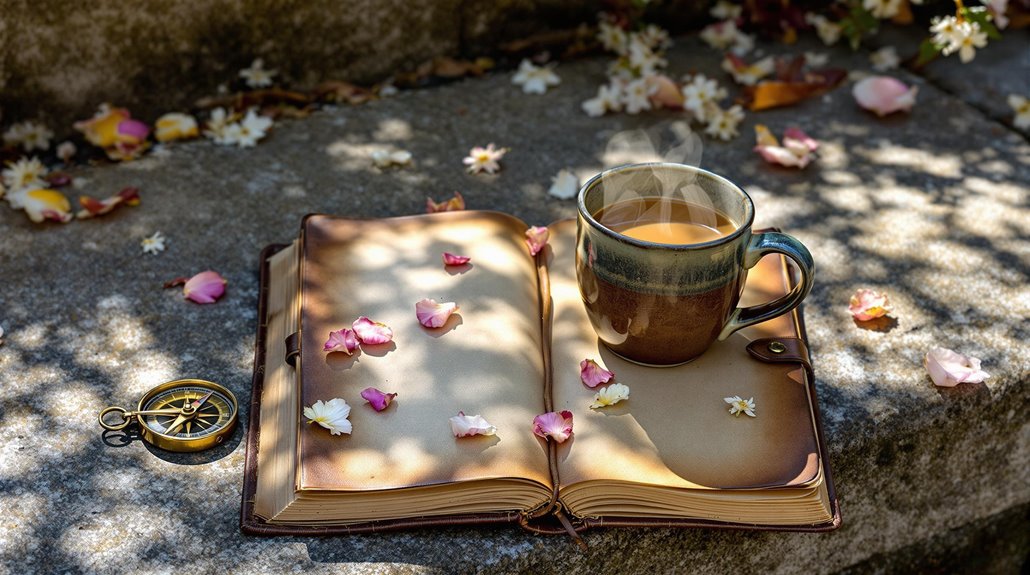
Stay present during your travels by embracing digital detox periods, practicing mindful movement through activities like hiking or yoga, and engaging all your senses to fully experience destinations. Document your journey through thoughtful journaling, use breathwork techniques to manage travel stress, and adopt slow travel principles to forge deeper connections with local communities. Incorporate meditation practices and culture activities to enhance your awareness, as these seven methods will transform your travel experience.
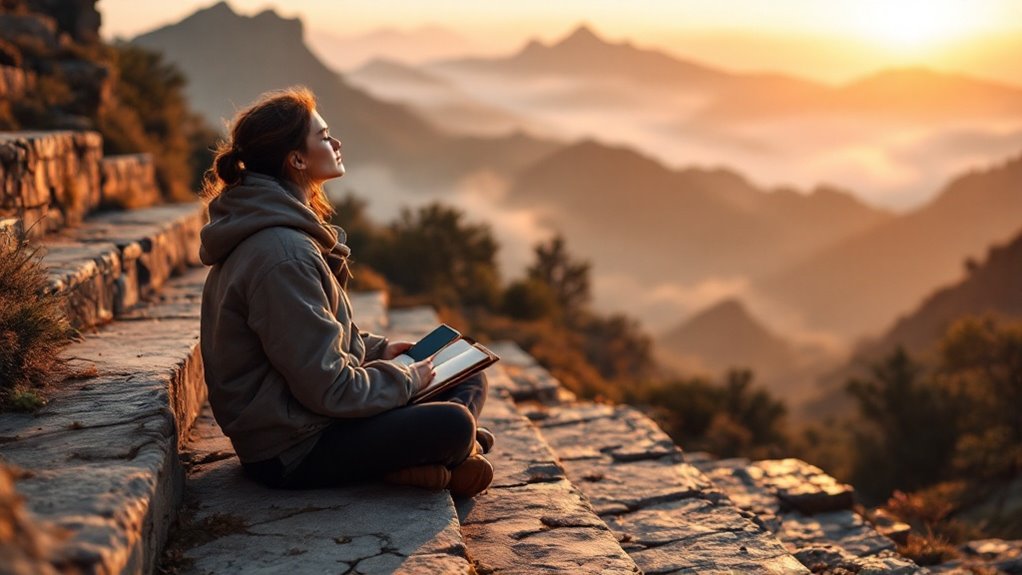
When was the last time you truly experienced a moment without reaching for your phone? With 62% of young adults reporting constant online connectivity, it’s time to contemplate a digital detox for your next adventure.
You’ll find plenty of options to help you disconnect, from phone-free cabins equipped with locked boxes and emergency Nokia phones to structured programs that keep devices safely stored away. The rising popularity of these experiences is evident, with companies like Unplugged seeing a 209% increase in bookings over the past year. Choosing eco-conscious accommodations can enhance your digital detox while minimizing your environmental impact.
While travel doesn’t guarantee personal transformation, mindful disconnection can create space for authentic cultural experiences and self-reflection. Traveling alone requires extra vigilance, especially during digital detox periods when staying aware of your surroundings is crucial.
To ease into the experience, start with shorter phone-free periods before committing to a multi-day detox. Contemplate destinations that naturally limit connectivity, like remote eco-lodges or historical sites in Istanbul and Cairo, where immersive experiences replace screen time.
For peace of mind, download offline maps beforehand and set up auto-replies to manage others’ expectations while you’re unplugged and fully present in your travels.
Moving mindfully through a new destination transforms ordinary travel activities into deeply enriching experiences.
You’ll find greater connection with your surroundings by practicing walking meditation, where you’ll focus on each step’s sensation and sync your breath with your movement. While exploring, pause regularly to notice your posture and engage consciously with your environment through simple exercises like balance poses or mindful stretching.
Try incorporating nature-based movement practices, such as hiking trails with attention to your body’s mechanics, or practicing yoga at sunrise in local parks. The lush tea plantations of Cameron Highlands provide an ideal backdrop for mindful movement practices. Consider extending your journey through Southeast Asian routes to discover more serene locations for mindfulness practices.
When you’re swimming, cycling, or kayaking, tune into the resistance and rhythm of your movements. Exploring Europe’s scenic landscapes by bike on guided bike tours offers a perfect opportunity to practice mindful movement. By staying present in your body while traveling, you’ll create a more immersive and meaningful journey through each destination.
Remember to observe your body’s sensations during aimless wandering, as this helps deepen your connection to the present moment.
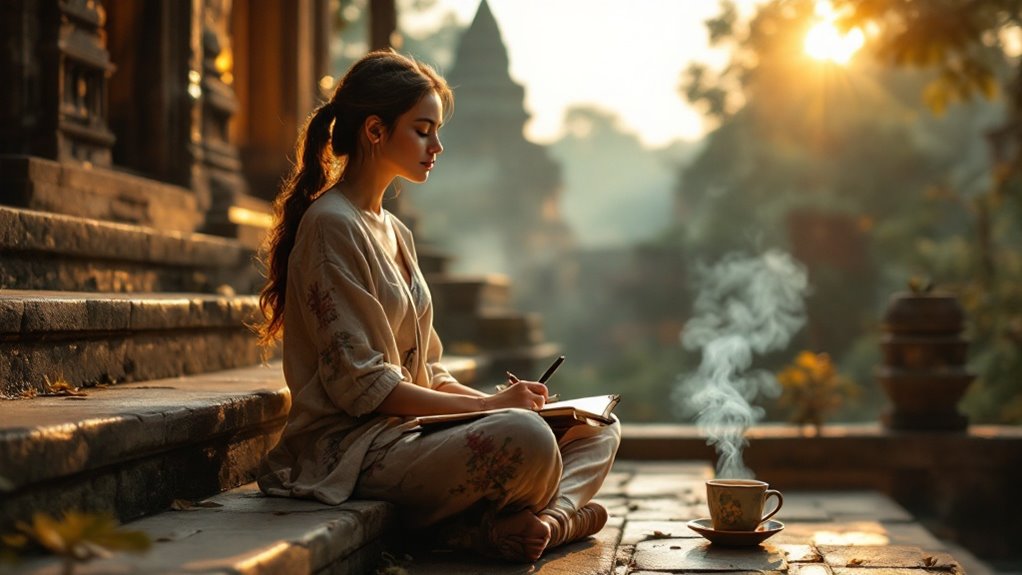
True immersion in travel requires engaging all your senses to fully experience each destination’s unique tapestry.
You’ll connect more deeply with each place by deliberately exploring its sensory landscape, from the bustling sounds of local markets to the textural contrasts of ancient architecture.
To enhance your sensory awareness while traveling:
Remember to take regular movement breaks throughout your explorations to maintain balanced sensory input and prevent overwhelm.
Consider carrying a small sensory travel kit with items like noise-canceling headphones and tactile objects to manage overstimulation while staying present.
Documenting your travels through journaling transforms fleeting moments into lasting memories while deepening your connection to each destination. You’ll discover that setting aside just 15 minutes daily to record your experiences creates an invaluable personal archive of your journey. Your journal becomes a creative outlet where you can express your unique perspective on different cultures and landscapes.
| Time of Day | Journaling Focus | Method |
|---|---|---|
| Morning | Plans & Dreams | Bullet Points |
| Afternoon | Sensory Details | Voice Notes |
| Evening | Reflections | Long-form Writing |
Keep your journal entries rich with sensory details by recording the aroma of local spices, the texture of ancient stones, or the melody of street musicians. Don’t forget to incorporate physical mementos like ticket stubs or pressed flowers, which add tangible dimensions to your written memories. This mindful documentation practice not only preserves your experiences but also helps you stay present throughout your travels.
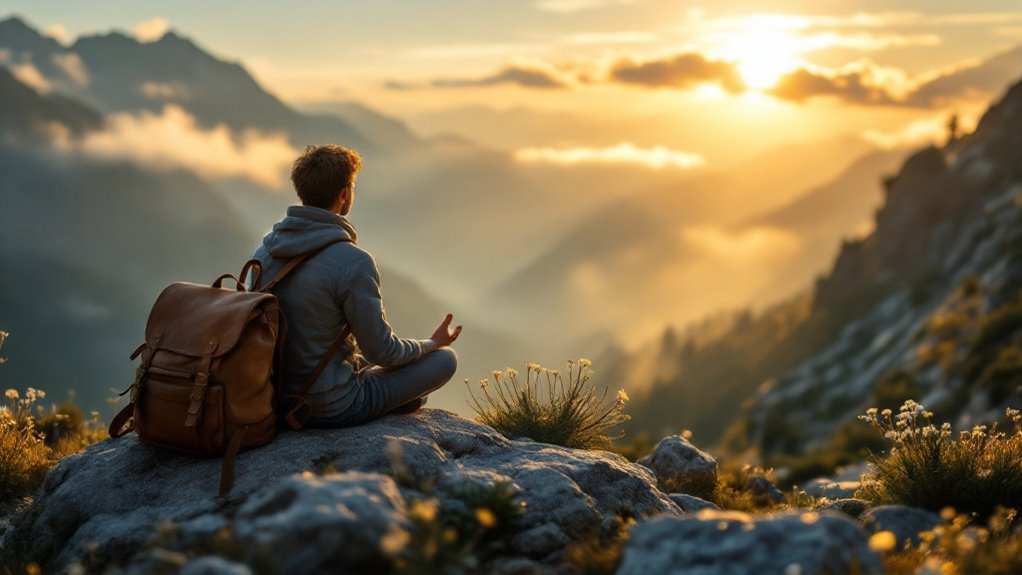
While managing the sensory overload of travel can feel overwhelming, mastering essential breathwork and meditation techniques will help you maintain inner calm throughout your journey.
When you’re facing turbulence, long security lines, or crowded terminals, try these proven methods to stay centered and relaxed. Triangle breathing technique, which involves equal counts of inhaling, holding, and exhaling, can provide immediate relief during stressful travel moments. Many vegan wellness retreats now incorporate these breathing practices into their daily programs.
Using GPSMyCity app can help you find quiet spots for meditation away from busy tourist areas. Many travelers now rely on mindfulness apps to guide their meditation practice while exploring new destinations. These techniques work best when practiced regularly, allowing you to tap into them naturally whenever travel stress arises.
Mastering inner calm through breathwork opens the door to an even deeper form of mindful travel.
Slow travel invites you to experience destinations with intention and awareness, rather than rushing from one tourist hotspot to another. You’ll discover that spending more time in fewer places not only reduces your carbon footprint but also enriches your connection to local communities and cultures. Cities like Chiang Mai offer vegan food havens that encourage mindful eating and cultural exploration.
Mindful exploration creates authentic connections, transforming tourist moments into meaningful cultural exchanges that leave lasting impressions on both traveler and destination.
When you embrace unhurried adventures, you’ll naturally gravitate toward sustainable practices like using public transportation, supporting local businesses, and participating in community events. Taking time to foster authentic relationships with locals creates meaningful connections that can last a lifetime.
This approach allows you to develop a deeper understanding of your surroundings while improving your mental well-being through reduced stress and increased mindfulness.
You’ll find yourself solving problems creatively, adapting to new environments, and discovering hidden gems that most travelers miss.
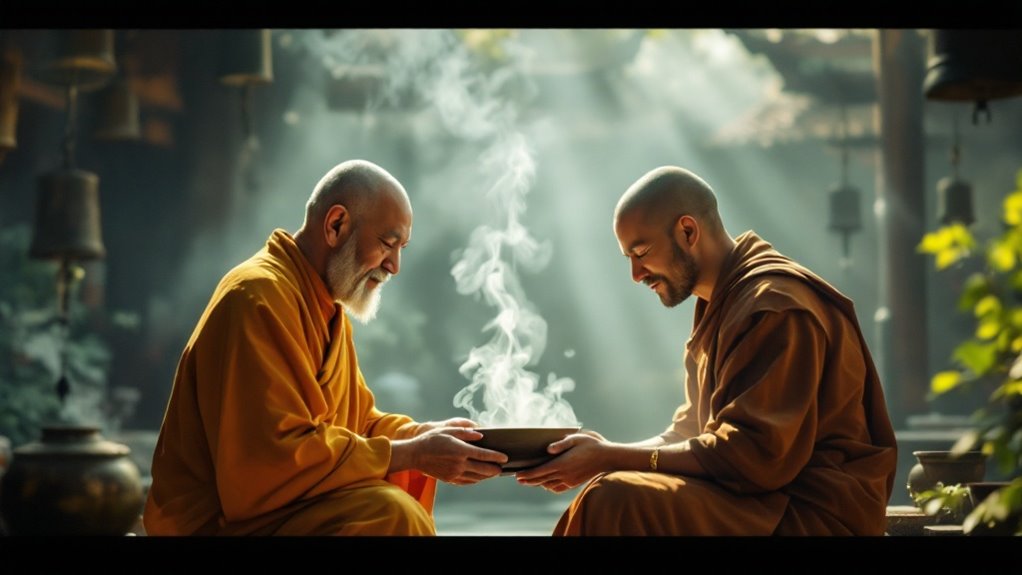
By practicing mindful immersion in local cultures, you’ll transform your travels from surface-level tourism into deeply meaningful experiences.
To truly connect with local communities and traditions, focus on authentic engagement through mindful observation and respectful participation. Seek out small-group activities to create a more intimate and comfortable environment for cultural exchange.
You can maintain mindfulness by creating dedicated quiet zones, scheduling practice times with roommates, using headphones for meditation, and finding outdoor spaces. Establish clear boundaries while respecting others’ routines and personal space.
Adapt your meditation practice to respect local customs. You’ll need to modify your routines, timing, and location. Consider learning and incorporating local mindfulness traditions while being flexible with your usual practices.
Focus on slow, controlled breathing while following your emergency protocols. Keep a clear mind by acknowledging your surroundings and emotions without judgment. Stay grounded through simple physical sensations like feeling your feet.
Yes, you can find zen even in the world’s busiest spots! Take deep breaths, focus on one sensation at a time, and use noise-canceling headphones. You’ll transform chaotic tourist crowds into opportunities for mindful observation.
You’ll overcome language barriers mindfully by staying calm, using clear gestures, and embracing non-verbal communication. Focus on your breath, practice active listening, and utilize translation apps when needed to stay present.
Like Dorothy discovering there’s no place like the present moment, you’ll find that mindful travel transforms ordinary journeys into extraordinary adventures. When you unplug, slow down, and learn about each experience, you’re not just collecting passport stamps – you’re collecting moments that’ll reshape your perspective. Take these tools with you, and you’ll discover that the real destination isn’t a place, but a state of conscious awareness.